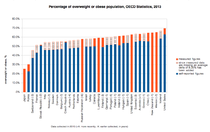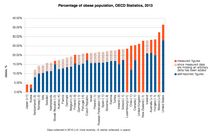Health is the level of functional ormetabolic efficiency of a living organism. In humans it is the ability of individuals or communities to adapt and self-manage when facing physical, mental or social challenges.[1] The World Health Organization (WHO) defined health in its broader sense in its 1948 constitution as "a state of complete physical, mental, and social well-beingand not merely the absence of disease or infirmity."[2][3] This definition has been subject to controversy, in particular as lacking operational value and because of the problem created by use of the word "complete" [4][5] Other definitions have been proposed, among which a recent definition that correlates health and personal satisfaction.[6][7]Classification systems such as the WHO Family of International Classifications, including the International Classification of Functioning, Disability and Health(ICF) and the International Classification of Diseases (ICD), are commonly used to define and measure the components of health.
Systematic activities to prevent or cure health problems and promote good health in humans are undertaken byhealth care providers. Applications with regard to animal health are covered by the veterinary sciences. The term "healthy" is also widely used in the context of many types of non-living organizations and their impacts for the benefit of humans, such as in the sense of healthy communities, healthy cities orhealthy environments. In addition tohealth care interventions and a person's surroundings, a number of other factors are known to influence the health status of individuals, including their background, lifestyle, and economic, social conditions, and spirituality; these are referred to as "determinants of health." Studies have shown that high levels of stress can affect human health.[8]
Determinants
See also: Social determinants of healthand Risk factor
Generally, the context in which an individual lives is of great importance for both his health status and quality of their life. It is increasingly recognized that health is maintained and improved not only through the advancement and application of health science, but also through the efforts and intelligentlifestyle choices of the individual and society. According to the World Health Organization, the main determinants of health include the social and economic environment, the physical environment, and the person's individual characteristics and behaviors.[9]
More specifically, key factors that have been found to influence whether people are healthy or unhealthy include the following:[9][10][11]

Donald Henderson as part of the CDC's smallpox eradication team in 1966.
An increasing number of studies and reports from different organizations and contexts examine the linkages between health and different factors, including lifestyles, environments, health care organization, and health policy – such as the 1974 Lalonde report from Canada;[11] the Alameda County Study in California;[12] and the series of World Health Reports of the World Health Organization, which focuses on global health issues including access to health care and improving public healthoutcomes, especially in developing countries.[13]
The concept of the "health field," as distinct from medical care, emerged from the Lalonde report from Canada. The report identified three interdependent fields as key determinants of an individual's health. These are:[11]
- Lifestyle: the aggregation of personal decisions (i.e., over which the individual has control) that can be said to contribute to, or cause, illness or death;
- Environmental: all matters related to health external to the human body and over which the individual has little or no control;
- Biomedical: all aspects of health, physical and mental, developed within the human body as influenced by genetic make-up.
The maintenance and promotion of health is achieved through different combination of physical, mental, and social well-being, together sometimes referred to as the "health triangle."[14][15]The WHO's 1986 Ottawa Charter for Health Promotion further stated that health is not just a state, but also "a resource for everyday life, not the objective of living. Health is a positive concept emphasizing social and personal resources, as well as physical capacities."[16]
Focusing more on lifestyle issues and their relationships with functional health, data from the Alameda County Study suggested that people can improve their health via exercise, enough sleep, maintaining a healthy body weight, limiting alcohol use, and avoidingsmoking.[17] Health and illness can co-exist, as even people with multiple chronic diseases or terminal illnesses can consider themselves healthy.[18]
The environment is often cited as an important factor influencing the health status of individuals. This includes characteristics of the natural environment, the built environment, and the social environment. Factors such as clean water and air, adequate housing, and safe communities and roads all have been found to contribute to good health, especially to the health of infants and children.[9][19] Some studies have shown that a lack of neighborhood recreational spaces including natural environment leads to lower levels of personal satisfaction and higher levels of obesity, linked to lower overall health and well being.[20] This suggests that the positive health benefits of natural space in urban neighborhoods should be taken into account in public policy and land use.
Genetics, or inherited traits from parents, also play a role in determining the health status of individuals and populations. This can encompass both thepredisposition to certain diseases and health conditions, as well as the habits and behaviors individuals develop through the lifestyle of their families. For example, genetics may play a role in the manner in which people cope withstress, either mental, emotional or physical. For example, obesity is a very large problem in the United States[citation needed] that contributes to bad mental health and causes stress in a lot of people's lives. (One difficulty is the issue raised by the debate over the relative strengths of genetics and other factors; interactions between genetics and environment may be of particular importance.)
Potential issues
There are a lot of types of health issues common with many people across the globe. Disease is one of the most common. According to GlobalIssues.org, approximately 36 million people die each year from non-communicable (not contagious) disease including cardiovascular disease cancer, diabetes, and chronic lung disease (Shah, 2014).[21]
As for communicable diseases, both viral and bacterial, AIDS/HIV,tuberculosis, and malaria are the most common also causing millions of deaths every year (2014).
Another health issue that causes death or contributes to other health problems is malnutrition majorly among children. One of the groups malnutrition affects most is young children. Approximately 7.5 million children under the age of 5 die from malnutrition, and it is usually brought on by not having the money to find or make food (2014).
Bodily injuries are also a common health issue worldwide. These injuries, including broken bones, fractures, and burns can reduce a person’s quality of life or can cause fatalities including infections that resulted from the injury or the severity injury in general (Moffett, 2013).[22]
Some contributing factors to poor health are lifestyle choices. These include smoking cigarettes, which according to LIVESTRONG.com kills 443,000 people each year (2013). It also can include a poor diet, whether it is overeating or an overly constrictive diet. Inactivity can also contribute to health issues and also a lack of sleep, excessive alcohol consumption, and neglect of oral hygiene (2013). There are also genetic disorders that are inherited by the person and can vary in how much they affect the person and when they surface (2013).
The one health issue that is the most unfortunate because the majority of these health issues are preventable is that approximately 1 billion people lack access to health care systems (Shah, 2014). It is easy to say that the most common and harmful health issue is that a lot of people do not have access to quality remedies.[23][24]
Mental health
Main article: Mental health
The World Health Organizationdescribes mental health as "a state ofwell-being in which the individual realizes his or her own abilities, can cope with the normal stresses of life, can work productively and fruitfully, and is able to make a contribution to his or her community".[25] Mental Health is not just the absence of mental illness.
Mental illness is described as 'the spectrum of cognitive, emotional, and behavioural conditions that interfere with social and emotional well-being and the lives and productivity of people. Having a mental illness can seriously impair, temporarily or permanently, the mental functioning of a person. Other terms include: 'mental health problem', 'illness', 'disorder', 'dysfunction'. (Hungerford et al. 2012).
Roughly a quarter of all adults 18 and over in the US suffer from a diagnosable mental illness. Mental illnesses are the leading cause of disability in the US and Canada. Examples include,schizophrenia, ADHD, major depressive disorder, bipolar disorder, anxiety disorder, post-traumatic stress disorderand autism.[26]
Many teens suffer from mental health issues in response to the pressures of society and social problems they encounter. Some of the key mental health issues seen in teens are:depression, eating disorders, and drug abuse. There are many ways to prevent these health issues from occurring such as communicating well with a teen suffering from mental health issues. Mental health can be treated and be attentive to teens' behavior.[27]
Maintaining health
Achieving and maintaining health is an ongoing process, shaped by both the evolution of health care knowledge and practices as well as personal strategies and organized interventions for staying healthy.
Diet
Main articles: Healthy diet andHuman nutrition

Percentage of overweight or obese population in 2010, Data source: OECD's iLibrary, http://stats.oecd.org, retrieved 2013-12-12[28]

Percentage of obese population in 2010, Data source: OECD's iLibrary, http://stats.oecd.org, retrieved 2013-12-13[29]
An important way to maintain your personal health is to have a healthy diet. A healthy diet includes a variety of plant-based and animal-based foods that provide nutrients to your body. Such nutrients give you energy and keep your body running. Nutrients help build and strengthen bones, muscles, and tendons and also regulate body processes (i.e.blood pressure). The food guide pyramidis a pyramid-shaped guide of healthy foods divided into sections. Each section shows the recommended intake for each food group (i.e. Protein, Fat, Carbohydrates, and Sugars). Making healthy food choices is important because it can lower your risk of heart disease, developing some types ofcancer, and it will contribute to maintaining a healthy weight.[30]
Exercise
Main article: Physical exercise
Physical exercise enhances or maintainsphysical fitness and overall health and wellness. It strengthens muscles and improves the cardiovascular system.
Role of science
Main articles: Health science andHealth care

The Dutch Public Health Service provides medical care for the natives of the Dutch East Indies, May 1946
Health science is the branch of science focused on health. There are two main approaches to health science: the study and research of the body and health-related issues to understand how humans (and animals) function, and the application of that knowledge to improve health and to prevent and cure diseasesand other physical and mental impairments. The science builds on many sub-fields, including biology,biochemistry, physics, epidemiology,pharmacology, medical sociology. Applied health sciences endeavor to better understand and improve human health through applications in areas such as health education, biomedical engineering, biotechnology and public health.
Organized interventions to improve health based on the principles and procedures developed through the health sciences are provided by practitioners trained in medicine,nursing, nutrition, pharmacy, social work, psychology, occupational therapy,physical therapy and other health care professions. Clinical practitioners focus mainly on the health of individuals, while public health practitioners consider the overall health of communities and populations. Workplace wellnessprograms are increasingly adopted by companies for their value in improving the health and well-being of their employees, as are school health services in order to improve the health and well-being of children.
Role of public health
Main article: Public health
See also: Global health

Postage stamp, New Zealand, 1933. Public health has been promoted – and depicted – in a wide variety of ways.
Public health has been described as "the science and art of preventing disease, prolonging life and promoting health through the organized efforts and informed choices of society, organizations, public and private, communities and individuals."[31] It is concerned with threats to the overall health of a community based onpopulation health analysis. The population in question can be as small as a handful of people or as large as all the inhabitants of several continents (for instance, in the case of a pandemic). Public health has many sub-fields, but typically includes the interdisciplinary categories of epidemiology, biostatisticsand health services. Environmental health, community health, behavioral health, and occupational health are also important areas of public health.
The focus of public health interventions is to prevent and manage diseases, injuries and other health conditions through surveillance of cases and thepromotion of healthy behavior,communities, and (in aspects relevant to human health) environments. Its aim is to prevent health problems from happening or re-occurring by implementing educational programs, developing policies, administering services and conducting research.[32] In many cases, treating a disease or controlling a pathogen can be vital to preventing it in others, such as during anoutbreak. Vaccination programs and distribution of condoms to prevent the spread of communicable diseases are examples of common preventive public health measures, as are educational campaigns to promote vaccination and the use of condoms (including overcoming resistance to such).
Public health also takes various actions to limit the health disparities between different areas of the country and, in some cases, the continent or world. One issue is the access of individuals and communities to health care in terms of financial, geographical or socio-cultural constraints to accessing and using services.[citation needed] Applications of the public health system include the areas of maternal and child health, health services administration, emergency response, and prevention and control ofinfectious and chronic diseases.
The great positive impact of public health programs is widely acknowledged. Due in part to the policies and actions developed through public health, the 20th century registered a decrease in the mortality rates forinfants and children and a continual increase in life expectancy in most parts of the world. For example, it is estimated that life expectancy has increased for Americans by thirty years since 1900,[33]and worldwide by six years since 1990.[34]
Self-care strategies
Main article: Self care
Personal health depends partially on the active, passive, and assisted cues people observe and adopt about their own health. These include personal actions for preventing or minimizing the effects of a disease, usually a chronic condition, through integrative care. They also include personal hygiene practices to prevent infection and illness, such asbathing and washing hands with soap;brushing and flossing teeth; storing, preparing and handling food safely; and many others. The information gleaned from personal observations of daily living – such as about sleep patterns, exercise behavior, nutritional intake and environmental features – may be used to inform personal decisions and actions (e.g., "I feel tired in the morning so I am going to try sleeping on a different pillow"), as well as clinical decisions and treatment plans (e.g., a patient who notices his or her shoes are tighter than usual may be having exacerbation of left-sided heart failure, and may require diuretic medication to reduce fluid overload).[35]
Personal health also depends partially on the social structure of a person's life. The maintenance of strong social relationships, volunteering, and other social activities have been linked to positive mental health and also increased longevity. One American study among seniors over age 70, found that frequent volunteering was associated with reduced risk of dying compared with older persons who did not volunteer, regardless of physical health status.[36] Another study from Singapore reported that volunteering retirees had significantly better cognitive performance scores, fewer depressive symptoms, and better mental well-being and life satisfaction than non-volunteering retirees.[37]
Prolonged psychological stress may negatively impact health, and has been cited as a factor in cognitive impairmentwith aging, depressive illness, and expression of disease.[38] Stress management is the application of methods to either reduce stress or increase tolerance to stress. Relaxation techniques are physical methods used to relieve stress. Psychological methods include cognitive therapy, meditation, and positive thinking, which work by reducing response to stress. Improving relevant skills, such as problem solvingand time management skills, reduces uncertainty and builds confidence, which also reduces the reaction to stress-causing situations where those skills are applicable.
Occupational health
Main article: Occupational safety and health
In addition to safety risks, many jobs also present risks of disease, illness and other long-term health problems. Among the most common occupational diseases are various forms ofpneumoconiosis, including silicosis andcoal worker's pneumoconiosis (black lung disease). Asthma is anotherrespiratory illness that many workers are vulnerable to. Workers may also be vulnerable to skin diseases, includingeczema, dermatitis, urticaria, sunburn, and skin cancer.[39][40] Other occupational diseases of concern include carpal tunnel syndrome and lead poisoning.
As the number of service sector jobs has risen in developed countries, more and more jobs have become sedentary, presenting a different array of health problems than those associated withmanufacturing and the primary sector. Contemporary problems, such as the growing rate of obesity and issues relating to stress and overwork in many countries, have further complicated the interaction between work and health.
Many governments view occupational health as a social challenge and have formed public organizations to ensure the health and safety of workers. Examples of these include the BritishHealth and Safety Executive and in theUnited States, the National Institute for Occupational Safety and Health, which conducts research on occupational health and safety, and the Occupational Safety and Health Administration, which handles regulation and policy relating to worker safety and health.[41][42][43]



No comments:
Post a Comment